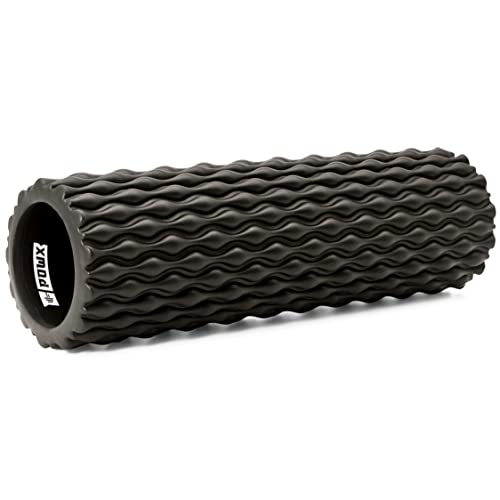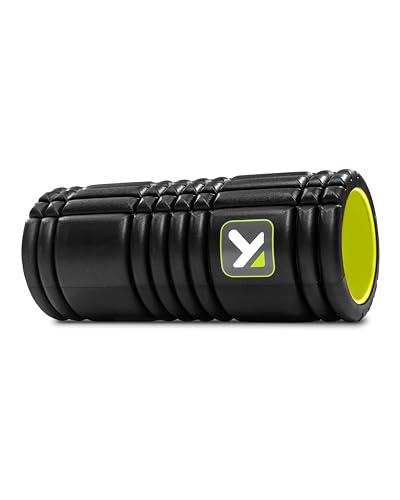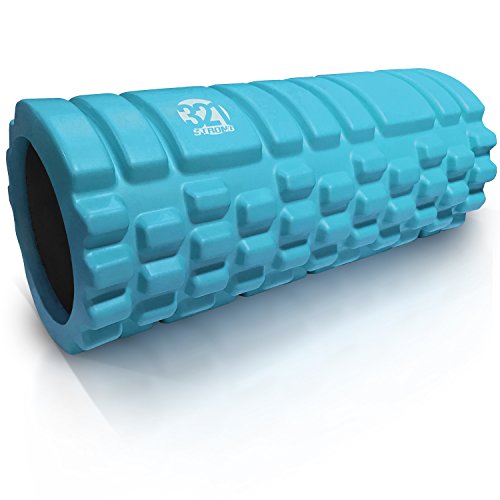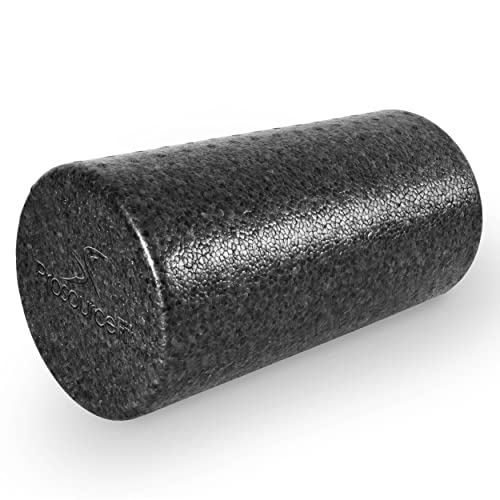Unlock Health: Benefits of a Foam Roller Revealed
As a wellness enthusiast on a mission to enhance my fitness routine, I've delved into the transformative world of foam rolling. This simple, yet powerful tool has become an integral part of my wellness journey, bringing forth myriad benefits, including improved muscle recovery, increased flexibility, and reduced soreness. Incorporating a foam roller into my exercise regime has not only streamlined my post-workout recovery but also fortified the very essence of my daily physical endurance. Now, I'm eager to share the compelling benefits of a foam roller and how it could be your ally in achieving peak physical wellbeing.
321 STRONG Foam Roller - Medium Density Muscle Massager
The 321 STRONG Foam Roller: Perfect for Soothing Sore Muscles after a Home Workout
Product information
$44.99 $32.85
Product Review Score
4.43 out of 5 stars
108 reviewsProduct links
Key Takeaways
- Discover the substantial benefits of a foam roller on muscle recovery and how it can fast-track your return to active training.
- Understand the critical role that foam rolling plays in boosting flexibility, preparing your body for a wide range of movements.
- Learn how regular use can lead to reduced soreness, making your workouts more enjoyable and less daunting.
- Embark on a wellness journey equipped with the knowledge to leverage the foam roller for optimal physical health.
- Find out why foam rolling is an applauded addition to fitness routines by experts and enthusiasts alike.
The Essential Guide to Foam Rolling for Recovery
For many of us embarking on intense physical training, foam rolling has become synonymous with a powerful recovery tool. Offering a plethora of benefits for foam rolling, athletes and fitness enthusiasts turn to this self-myofascial release technique to alleviate sore muscles and enhance muscle recovery. Let's unravel how this simple yet impactful practice can be seamlessly integrated into your wellness regimen for maximum results.
How Foam Rollers Aid Muscle Recovery
Imagine giving your overworked muscles a form of deep tissue massage that you can control and administer at your convenience. That's precisely the kind of respite foam rolling offers. By targeting various muscle groups, it helps to ease tension and promote the healing of muscle fibers.
The Anatomy of a Foam Roller and Its Use
Choosing the right foam roller is like selecting the right pair of shoes; it should fit your needs and enhance your comfort. They come in diverse shapes and sizes, addressing different needs, from long, smooth cylinders to compact, textured designs crafted to reach deeper layers of tissue.
Comparing Foam Rollers to Traditional Massage Tools
Now, you might wonder how foam rollers stand against the likes of massage guns and other traditional massage tools. While tools like the Hyperice and Renpho massage guns provide targeted, percussive therapy to muscles, foam rolling encompasses a broader scope, engaging muscle fascia and larger areas for deep, sustained pressure and holistic recovery.
"Foam rolling after a challenging workout decreases not only muscle soreness but also shortens recovery time, making it an invaluable part of my training." - Quoted from a top-tier athletic coach emphasizing the benefits of foam rolling.
- Alleviate muscle tension
- Decrease delayed-onset muscle soreness (DOMS)
- Improve range of motion
- Correct muscle imbalances
| Recovery Tool | Pressure Type | Best Use |
|---|---|---|
| Foam Roller | Diffuse, Deep | Large muscle groups, fascia release |
| Massage Gun | Targeted, Percussive | Deep tissue massage, specific sore spots |
In my experience, the practice of foam rolling not only offers immediate relief from sore muscles but also contributes to an overall well-being that's paramount for consistent athletic performance. Whether you're a professional athlete or an everyday fitness enthusiast, recognizing the benefits of foam rolling could be the turning point in what you can expect from your body's recovery capabilities. Consider integrating it into your routine and feel the difference.
Unlocking Flexibility and Mobility with Foam Rolling
As someone who prioritizes wellness and fitness, I've discovered that foam rolling is more than just a recovery tool; it's a gateway to enhanced flexibility and improved mobility. The immediate relief it provides from muscle tension is almost magical, and its benefits for increasing my range of motion have been nothing short of transformative.
https://www.youtube.com/watch?v=v0n81ZoeMFc
Incorporating foam rolling into my warm-ups has remarkably prepared my muscles for the activities ahead. It's not just a preparatory step; it's an integral part of my strength training sessions, both before and after, ensuring optimal blood circulation. This practice doesn't just prepare my muscles; it revitalizes them by assisting in the removal of metabolic byproducts like lactic acid.
The pecs can be particularly problematic; when tight, they cause an unappealing hunch in the shoulders. Regularly working on these muscles with my foam roller not only eases the tightness but helps maintain a posture that exudes confidence and poise.
- Warm-up routines with foam rolling to prep muscles
- Posture improvement through consistent foam rolling
- Increase in blood flow pre- and post- strength training
- Immediate impact on flexibility and potential for long-term improvements
While I've felt the immediate impact of foam rolling on my flexibility, I'm intrigued by the ongoing research into its long-term benefits. As someone committed to regular self-care, I'll be following these studies closely, eager to learn more about how this simple tool can continue to enhance my mobility and overall wellbeing.
Enhancing Athletic Performance Through Foam Rolling
As I delve into my routine, I incorporate foam rolling as a staple element to boost my athletic performance. The benefits of this practice are manifold, particularly for those of us dedicated to strength training and seeking to harmonize our body’s capabilities. Muscle imbalances, a common issue among athletes, can lead to a ripple effect of diminished performance and higher injury risk. Addressing these imbalances is critical, and foam rolling stands as an effective tool to do just that.
The act of foam rolling can almost be seen as a daily tune-up for your muscles, ensuring everything runs smoothly and efficiently. It's like taking your car in for a service, except you're both the vehicle and the mechanic. When I roll out my hip flexors especially after a lengthy bike ride or a grueling leg day, I'm effectively unlocking a greater range of motion. This is essential to not only performing movements correctly but also to making incremental gains in my strength training regimen.:
| Muscle Group | Benefits of Foam Rolling | Common Imbalances Addressed |
|---|---|---|
| Hip Flexors | Increases hip mobility, reduces tightness | Anterior pelvic tilt, uneven stride |
| Hamstrings | Improves leg extension, enhances flexibility | Muscle tightness, posterior pelvic tilt |
| Calves | Supports ankle mobility, prevents cramps | Imbalanced gait, overpronation |
| Upper Back | Reduces tension, facilitates upright posture | Rounded shoulders, thoracic kyphosis |
In my pursuit of athletic excellence, I've found that foam rolling serves as more than just a preventative measure or recovery technique. It actively plays into enhancing my performance on the field and in the gym. By making foam rolling a non-negotiable part of my routine, I'm setting the stage for peak physical execution. Whether it’s before hitting the weights or after a rigorous cardio session, embracing the roll is key to keeping muscle imbalances at bay and my performance consistently on the rise.
Diving Deeper: Understanding Myofascial Release
As I explore the nuances of self-care in fitness, I've become particularly fascinated with the self-myofascial release technique. Not just a trend, this science-backed approach works wonders for those who want to maintain peak muscle function and care for their soft tissues. Let's delve into why this method has gained such traction and how it can benefit your overall wellness.
The Concept of Self-Myofascial Release Technique
Imagine being able to treat your own muscle tightness and improve mobility without needing a professional massage therapist at every turn. That's the premise of self-myofascial release. By using tools like foam rollers, we can apply pressure to specific points on the body, promoting relaxation of the muscles and fascia. I've found that this technique doesn't just ease aches; it enhances my flexibility and preps my muscles for the next workout.
The Role of Fascia in Muscle Function
Now, for the fascia - it's like your body's suit of armor for muscles and organs. Healthy fascia is essential for optimal muscle function, allowing you to move with ease and fluidity. When it's not properly maintained through techniques like self-myofascial release, we often experience stiffness and discomfort. Making this practice a regular part of my fitness regimen has been a game-changer, especially when it comes to joint mobility and muscle imbalances.
It's not just about short-term relief; it's about keeping my body functional and pain-free for years to come.
| Method | Primary Benefit | Equipment Needed |
|---|---|---|
| Self-Myofascial Release | Reduces tissue tightness | Foam Roller |
| Static Stretching | Improves muscle flexibility | No equipment |
| Dynamic Stretching | Enhances athletic performance | Various (depends on the exercise) |
Whether you're an athlete or someone who just wants to stay active without pain, integrating self-myofascial release into your routine could be a pivotal step. I encourage you to give it a try and feel the difference in your muscle function and flexibility—it's certainly made a noticeable impact in mine.
Integrating Foam Rolling into Your Exercise Regime
As someone passionate about fitness, I've discovered the foam rolling advantages firsthand. Whether you're gearing up for a heavy lift or unwinding post-cardio, foam rolling is an optimal way to prepare and repair your muscle groups. But when is the best time to shift the roller across your muscles, and how can you address those pesky knots in muscles? Let's dive into the strategies for incorporating this effective technique into your regimen.
Before or After: The Best Time to Use a Foam Roller
While some gym-goers swear by rolling out those tight spots before a workout, others find solace in the soothing pressure post-exercise. Here’s my take: Before a workout, a quick roll primes my muscles for the strain they’re about to endure. It's like sending an RSVP to my muscles, letting them know it's time to perform. After the push and pull of an intense session, foam rolling is my must-have recovery tactic, essential for working through the stiffness and maintaining muscle health.
Key Foam Roller Moves for Different Muscle Groups
Now, let’s get into the specifics. Ever wonder how you can maximize the impact on different areas of your body? Joy Puleo’s insights highlight the best foam roller moves to keep your muscles happy and performance on point. From your sturdy back muscles to your propelling calves, here’s a table to keep your foam rolling on track:
| Muscle Group | Movement | Holding Time | Notes |
|---|---|---|---|
| Back | Gentle rolling up and down | 15-30 seconds | Keep the spine neutral and don't arch excessively. |
| IT Band | Side-lying, rolling mid-thigh to knee | 20-60 seconds | Shift weight forward slightly to intensify. |
| Hips/Glutes | Crossed-leg, target one side at a time | 30-60 seconds | Great for those who sit often. |
| Calves | Sitting, roller under calf, roll from ankle to knee | 15-30 seconds | Change angles to reach side muscles. |
| Hamstrings | Under thigh, roll from just above knee to under glutes | 15-30 seconds | Can be intensified by stacking legs. |
With these foam rolling techniques in your toolbox, you’re well on your way to a more flexible, resilient, and balanced body. Remember to be mindful of the pressure and never rush the roll; the goal is to facilitate healing and enhance your fitness journey, not to push into pain. Embrace the roll and let it pave the way to your next workout triumph. Happy rolling!
Benefits of a Foam Roller
As I discovered on my wellness journey, the benefits of a foam roller can significantly improve posture, reduce muscle soreness, and enhance recovery. By integrating a foam roller into my routine, I've experienced a notable reduction in discomfort and an overall increase in body fluidity. Below, I've outlined the key improvements that foam rolling has contributed to my physical health.
TriggerPoint 13" Foam Roller - Relieves Muscles, Boosts Mobility
Release tension and improve flexibility with the TriggerPoint 13" Foam Roller - Your solution for muscle relief and increased mobility
Product information
$36.99 $27.49
Product Review Score
4.88 out of 5 stars
174 reviewsProduct links
- **Posture Improvement:** Foam rolling has been a game changer for my posture. By loosening up tight muscles, I've been able to return my body to a more natural, aligned state.
- **Soreness Reduction:** Those aches and pains after a heavy workout? They've become a thing of the past since I started using my foam roller to ease muscle tension.
- **Recovery Enhancement:** My recovery periods have dramatically shortened, leaving me feeling rejuvenated and ready for my next workout much quicker than I used to.
Furthermore, I've noticed that breaking down adhesions with a foam roller is like giving my muscles a new lease on life, offering a smoother range of motion. Keeping this in mind, let's dive deeper into how a foam roller can benefit different aspects of physical health.
| Aspect of Health | Benefits of Foam Rolling |
|---|---|
| Muscle Soreness | Alleviates tightness and reduces pain in affected muscles. |
| Posture | Improves alignment by relieving muscle tension, especially around the shoulders and back. |
| Recovery Time | Shortens downtime by promoting faster healing and muscle regeneration. |
| Flexibility and Mobility | Increases joint range of motion and reduces the risk of injuries. |
| Blood Flow | Helps to circulate blood more effectively, aiding nutrient delivery and metabolic waste removal. |
From my experience, using a foam roller has been essential to not only maintain but improve my physical wellness. If you're looking for an approach to combat muscle soreness, boost recovery, and transform your posture, consider embracing the foam roller – your body will thank you for it.
Why Foam Rolling Should Be Your Go-To Post-Workout
As someone passionate about fitness, I've discovered that integrating foam rolling into my routine has drastically improved my recovery times and alleviated my post-workout soreness. This simple tool's ability to reduce pain and enhance comfort after an intense workout session is not only remarkable but necessary for anyone serious about their wellness. Let me share with you why foam rolling should be non-negotiable in your post-exercise regimen.
Reducing Delayed Onset Muscle Soreness (DOMS)
Those familiar twinges of discomfort that creep in a day or two after a tough workout, known as DOMS, can be a real hindrance to maintaining a consistent exercise schedule. Thankfully, foam rolling has been a game-changer. Studies suggest that the pressure from foam rolling helps mitigate these pains significantly, and I can attest to that through personal experience. The rolling motion not only eases tension in the muscles but also prepares them for the next round of activity, keeping you on track with your fitness goals.
Promoting Blood Circulation and Waste Removal
The secret to quick recovery is improved blood flow. The enhanced circulation that comes from foam rolling means oxygen and nutrients get delivered more efficiently to fatigued muscles. Not only does this boosts recovery, but it also helps in expediting the removal of metabolic wastes like lactic acid, which we all know can be a real nemesis after a heavy lifting session. After rolling out a sore muscle, the difference in how I feel the next day is noticeable. My muscles feel ready much sooner than when I skip this crucial step.
The Science of Foam Rolling: A Closer Look at the Research
When diving into the scientific studies behind foam rolling, I always find myself intrigued by the unfolding evidence on how this practice can bolster muscular performance and expedite recovery from muscle damage. Despite the burgeoning interest within the fitness community, it is critical to note that the scientific foundation, while encouraging, comprises a relatively narrow pool of research. The studies available, however, enlighten us on the moderate efficacy of foam rolling in enhancing our range of motion—an aspect keenly sought after by anyone keen on maintaining an active lifestyle.
ProsourceFit 12" High Density Foam Roller for Full Body Workout
The ultimate tool for muscle recovery and flexibility enhancement
Product information
$11.94
Product Review Score
4.69 out of 5 stars
191 reviewsProduct links
In my exploration of current literature, I have encountered findings that lend support to incorporating foam rolling into our regular fitness regimens. The low risk associated with this technique aligns perfectly with the positive outcomes often reported by athletes and fitness aficionados alike. Although additional, more comprehensive studies remain a requisite to deepen our understanding, the consensus thus far points to significant advantages with minimal downsides.
Below, I summarize a few key aspects touched upon by research:
- Improved blood flow to muscle tissues
- Promotion of flexibility and range of motion
- Decreased recovery time after rigorous physical activity
- Assistance in the mitigation and treatment of muscle soreness
It is exhilarating to watch the landscape of scientific inquiry into foam rolling expand. As I continue to incorporate this practice into my routine, I stay attuned to the evolving evidence that shapes our understanding and application of this simple, yet powerful tool.
Choosing the Right Foam Roller for Your Needs
Finding the perfect foam roller is akin to selecting a favorite coffee blend – it's highly personal and depends on your unique fitness journey. With options spanning from smooth to ribbed textures, my aim is to provide you with insight to navigate the plentiful assortment available. As we delve into the specifics, you'll be equipped to make an informed choice that aligns with your body's demands and your wellness aspirations.
Understanding Different Types and Textures of Foam Rollers
First, let's unpack the variety on offer. Smooth foam rollers, often presented in lighter shades, are typically softer and provide uniform pressure – perfect for those taking their first plunge into foam rolling. As your body adapts, you might consider textured foam rollers. They mimic the hands of a masseuse, targeting those persistent knots more effectively. The distinct designs, from rigid grids to gentle waves, cater to various intensities and muscle recovery needs. Among the novel trends are vibrating foam rollers, adding an extra dimension of relief and muscle stimulation to the conventional foam rolling experience.
Personal Recommendations from Fitness Experts
Having consulted various fitness gurus, the consensus is clear: when choosing a roller, focus on balance. It should be firm enough to achieve therapeutic benefits yet forgiving enough to avoid discomfort. A medium-density roller can serve as a versatile tool for various muscle groups. Let's not overlook the role of personal comfort. After all, if the tool feels too harsh, it may discourage regular use, undermining the practice's advantages. Ultimately, it is your body's response that guides the best choice, and taking cues from that internal wisdom will lead to a more harmonious relationship with your chosen foam roller.
FAQ
What are the benefits of using a foam roller?
Foam rollers can help with muscle recovery, enhance flexibility, decrease muscle soreness, and be a valuable addition to your wellness journey. They are also known for improving posture, increasing range of motion, and promoting better circulation.
How does foam rolling aid in muscle recovery?
Foam rolling applies targeted pressure to muscle groups, promoting self-myofascial release. This helps in breaking up knots and tension in the muscles, reducing soreness, and speeding up the recovery process post-exercise. It's an effective way to aid the muscles' healing after an intense workout.
What is the anatomy of a foam roller and how do I use it?
A foam roller is a cylindrical tool usually made from dense foam. You use it by placing it under your body and using your body weight to apply pressure on tight spots, slowly rolling over different muscle groups to relieve tension and soothe sore muscles.
How do foam rollers compare to traditional massage tools?
Unlike massage guns that offer targeted, intense vibrations, foam rollers provide a broader, more diffused pressure across the muscle, which can be more effective for releasing tightness along a wider area of soft tissues and encourage a more profound deep tissue massage experience.
Why is foam rolling effective for enhancing flexibility and mobility?
Foam rolling stretches and loosens the muscles and fascia, which can reduce muscle tension and increase your range of motion. This encourages enhanced flexibility and improved mobility, especially when incorporated into a regular fitness routine.
How can foam rolling enhance my athletic performance?
Regular foam rolling can correct muscle imbalances, alleviate tight spots, and increase range of motion, all of which can contribute to improved athletic performance. It can also prepare your muscles for strength training and help reduce the risk of injury.
What is the self-myofascial release technique?
The self-myofascial release technique involves applying sustained pressure to the myofascial connective tissue to relieve tightness and restore normal function. Using a foam roller for this purpose can help you target specific knots or areas of high muscle tension.
What is the role of fascia in muscle function?
Fascia is a connective tissue that surrounds and supports muscles, bones, and organs. When it's healthy, it allows for smooth and unrestricted movement. Foam rolling helps to maintain the fascia's suppleness, ensuring optimal muscle function and mobility.
Should I use a foam roller before or after exercising?
Foam rolling is beneficial both before and after exercising. Rolling before a workout can help prepare the muscles by improving blood flow and flexibility. Post-exercise rolling can aid in recovery by addressing muscle soreness and improving blood circulation to flush out toxins.
What are some key foam roller moves for different muscle groups?
Some essential foam roller moves include rolling the calves, hamstrings, quads, IT band, glutes, back, and lats. Each move typically involves positioning the roller under the muscle group and using your body weight to massage and release tightness.
How can a foam roller improve my posture?
Foam rolling can alleviate muscle tightness that contributes to poor posture. Regularly rolling out areas like the shoulders, chest, and upper back can help correct muscular imbalances and lead to an overall improvement in posture.
Why is foam rolling recommended post-workout?
Foam rolling post-workout is recommended to reduce delayed onset muscle soreness (DOMS) and promote quicker recovery. The act of rolling can improve blood circulation, which helps in nutrient delivery and waste removal from the muscles.
What does scientific research say about foam rolling?
Scientific studies indicate moderate benefits of foam rolling, particularly in improving range of motion and reducing post-exercise soreness. While more research is needed for conclusive findings, foam rolling is generally considered a low-risk addition to aid in muscle recovery and performance.
How do I choose the right foam roller for my needs?
Selecting the right foam roller involves considering your pain tolerance, experience level, and specific needs. Beginners may start with a smooth foam roller and progress to textured foam rollers for deeper massages. Vibrating foam rollers can also be a good choice for an amplified effect.
What are personal recommendations from fitness experts for foam rolling?
Fitness experts often recommend using foam rollers that align with your comfort level and the intensity of massage you require. They suggest starting with lighter rollers and gradually moving to firmer ones as your tolerance increases. Experts also recommend focusing on muscle groups that feel tight and spending adequate time on each area for the best results.
Source Links




